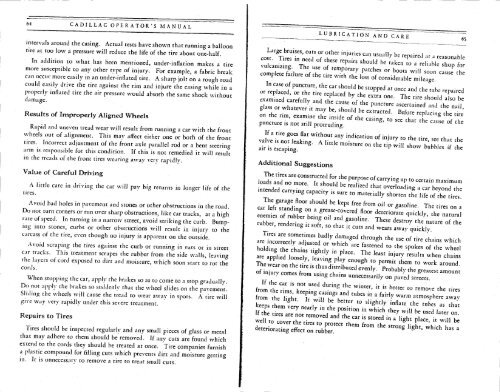1928 Cadillac - GM Heritage Center
1928 Cadillac - GM Heritage Center
1928 Cadillac - GM Heritage Center
Create successful ePaper yourself
Turn your PDF publications into a flip-book with our unique Google optimized e-Paper software.
64 CADILLAC OPERATOR'S MANUAL<br />
intervals around the casing. Actual tests have shown that running a balloon<br />
tire at too low a pressure will reduce the life of the tire about one-half.<br />
In addition to what has been mentioned, under-inflation makes a tire<br />
more susceptible to any other type of injury. For example, a fabric break<br />
can occur more easily in an under-inflated tire. A sharp jolt on a rough road<br />
could easily drive the tire against the rim and injure the casing while in a<br />
properly inflated tire the air pressure would absorb the same shock without<br />
damage.<br />
Results of Improperly Aligned Wheels<br />
Rapid and uneven tread wear will result from running a car with the front<br />
wheels out of alignment, This may affect either one or both of the front<br />
tires. Incorrect adjustment of the front axle parallel rod or a bent steering<br />
arm is responsible for this condition. If this is not remedied it will result<br />
in the treads of the front tires wearing away very rapidly.<br />
Value of Careful Driving<br />
A little care in driving the car will pay big returns in longer life of the<br />
tires.<br />
Avoid bad holes in pavement and stones or other obstructions in the road.<br />
Do not turn corners or run over sharp obstructions, like car tracks, at a high<br />
rate of speed. In turning in a narrow street, avoid striking the curb. Bumping<br />
into stones, curbs or other obstructions will result in injury to the<br />
carcass of the tire, even though no injury is apparent on the outside.<br />
Avoid scraping the tires against the curb or running in ruts or in street<br />
car tracks. This treatment scrapes the rubber from the side walls, leaving<br />
the layers of cord exposed to dirt and moisture, which soon start to rot the<br />
cords.<br />
When stopping the car, apply the brakes so as to come to a stop gradually.<br />
Do not apply the brakes so suddenly that the wheel slides on the pavement.<br />
Sliding the wheels will cause the tread to wear awav in spots. A tire will<br />
give way very rapidly under this severe treatment.<br />
Repairs to Tires<br />
Tires should be inspected regularly and any small pieces of glass or metal<br />
that may adhere to them should be removed. If any cuts are found which<br />
extend to the cords they should be treated at once. Tire companies furnish<br />
a plastic compound for filling cuts which prevents dirt and moisture getting<br />
in. It is unnecessarv to remove a tire to treat small cuts.<br />
LUBRICATION AND CARE 65<br />
Large bruises, cuts or other injuries can usually be repaired at a reasonable<br />
cost. Tires in need of these repairs should be taken to a reliable shop for<br />
vulcanizing. The use of temporary patches or boots will soon cause the<br />
complete failure of the tire with the loss of considerable mileage.<br />
In case of puncture, the car should be stopped at once and the tube repaired<br />
or replaced, or the tire replaced by the extra one. The tire should also be<br />
examined carefully and the cause of the puncture ascertained and the nail,<br />
glass or whatever it may be, should be extracted. Before replacing the tire<br />
on the rim, examine the inside of the casing, to see that the cause of the<br />
puncture is not still protruding.<br />
If a tire goes flat without any indication of injury to the tire, see that the<br />
valve is not leaking. A little moisture on the tip will show bubbles if the<br />
air is escaping.<br />
Additional Suggestions<br />
The tires are constructed for the purpose of carrying up to certain maximum<br />
loads and no more. It should be realized that overloading a car beyond the<br />
intended carrying capacity is sure to materially shorten the life of the tires.<br />
The garage floor should be kept free from oil or gasoline. The tires on a<br />
car left standing on a grease-covered floor deteriorate quickly, the natural<br />
enemies of rubber being oil and gasoline. These destroy the nature of the<br />
rubber, rendering it soft, so that it cuts and wears away quickly.<br />
Tires are sometimes badly damaged through the use of tire chains which<br />
are incorrectly adjusted or which are fastened to the spokes of the wheel<br />
holding the chains tightly in place. The least injury results when chains<br />
are applied loosely, leaving play enough to permit them to work around.<br />
The wear on the tire is thus distributed evenly. Probably the greatest amount<br />
of injury comes from using chains unnecessarily on paved streets.<br />
If the car is not used during the winter, it is better to remove the tires<br />
from the rims, keeping casings and tubes in a fairly warm atmosphere away<br />
from the light. It will be better to slightly inflate the tubes as that<br />
keeps them very nearly in the position in which they will be used later on.<br />
If the tires are not removed and the car is stored in a light place, it will be<br />
well to cover the tires to protect them from the strong light, which has a<br />
deteriorating effect on rubber.
















